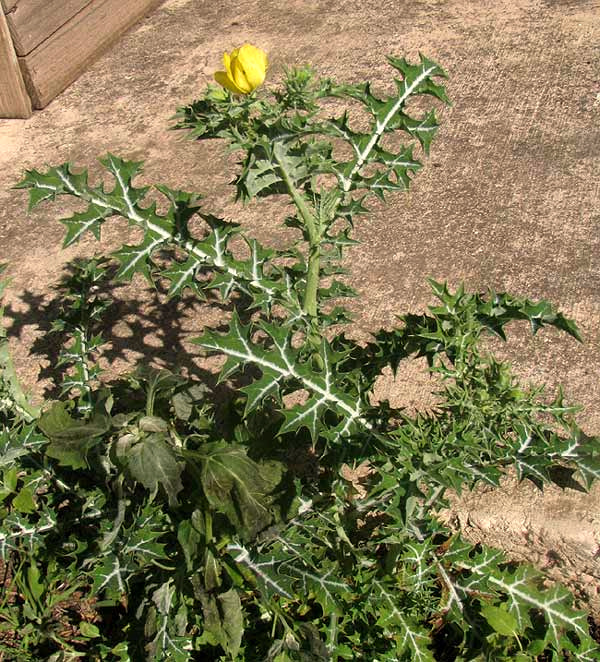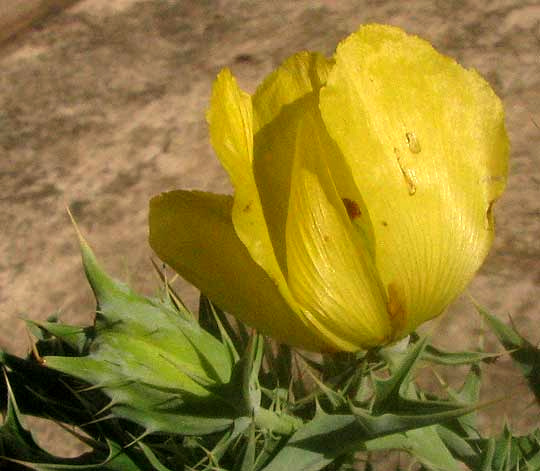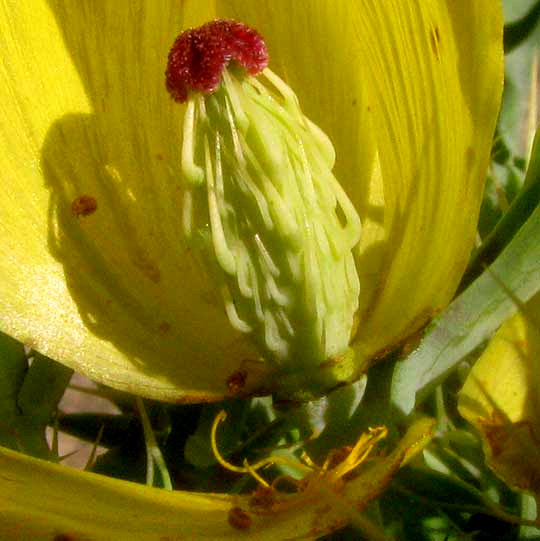Excerpts from Jim Conrad's
Naturalist Newsletter

from the April 27, 2014 Newsletter issued from the Frio Canyon Nature Education Center in the valley of the Dry Frio River in northern Uvalde County, southwestern Texas, on the southern border of the Edwards Plateau; elevation ~1750m (~5750 ft); N29.62°, W99.86°; USA
MEXICAN PRICKLY POPPY
In this area we've already looked at white-flowered and rose-flowered prickly poppy species. At the edge of a concrete walk at my neighbor Phred's, a yellow-flowered one is blossoming, shown above. A close-up of a flower with a spiny flower bud below it and to the left is shown below:
 .
.
Prickly poppy petals don't last long and are shed easily when the flower is handled. A view inside a blossom whose petals and stamens have fallen off one side appears below:

The spiny, egg-shaped item in the blossom's center is the ovary and atop it is the purple stigma, its lobes fuzzy to catch pollen. You can see that this ovary means to bear some large, stiff spines when it matures into a capsular fruit.
In North America fifteen prickly poppy species -- fifteen members of the genus Argemone -- occur in the wild. Most of those produce white or pale lavender blossoms, with only three species bearing yellow, golden or bronze flowers. Two of those yellow-flowered taxa might be found in our area. Blossoms of one of those species, Argemone aenea, have 150 or more stamens with red or purplish filaments, while flowers of the other one, Argemone mexicana, bear only 20-75 stamens with yellow filaments. A quick glimpse at our last picture convinces us that here we have ARGEMONE MEXICANA, the Mexican Prickly Poppy.
In southwestern Texas, Mexican Prickly Poppies are regarded as invasive weeds, as they are in many of the world's warmer countries and regions. It's unclear where they are native to, though many suppose that they originated from Mexico and Central America. In much of Africa and Asia Mexican Prickly Poppy is regarded as a serious agricultural weed, especially because livestock won't eat it, and the plants produce chemicals that retard seed germination and seedling growth of many plants. Such chemical inhibition of other plants' germination and growth is referred to as allelopathy. Harmful allelopathic effects of Mexican Prickly Poppies on germination and seedling vigor of wheat, mustard, sorghum, tomato, cucumber and many other useful plants have been documented
Despite all that, most pages on the Internet concerning Mexican Prickly Poppy deal with the plant's medicinal and psychotrophic uses. Some people smoke the leaves to feel relaxed or have highs of various kinds, the effects being similar to those of opium, the Opium Poppy being in the same family as prickly poppies. Mexico's Aztecs used this species extensively in rituals. In today's drug culture, some regard Mexican Prickly Poppy as a "teacher plant," a plant whose use engenders deep insight. In the Caribbean, plasters made from the plant are used to remove warts. In fact, the plant finds all kinds of uses in many cultures throughout the world.